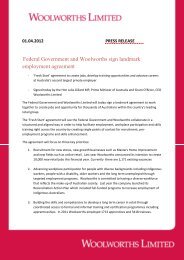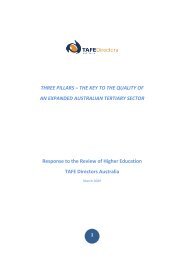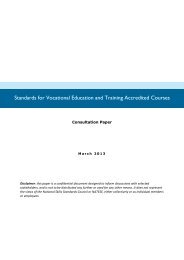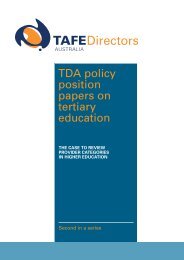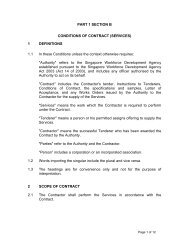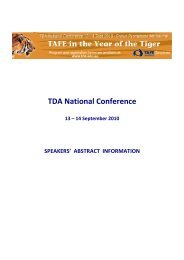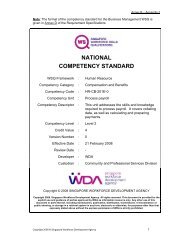Occasional Paper - TAFE Directors Australia
Occasional Paper - TAFE Directors Australia
Occasional Paper - TAFE Directors Australia
You also want an ePaper? Increase the reach of your titles
YUMPU automatically turns print PDFs into web optimized ePapers that Google loves.
36<br />
and experience that are needed for them to direct<br />
their institutes in the new, demand-driven and<br />
competitive training market.<br />
This Bill represents one of the most significant<br />
reforms to education and training in Victoria in<br />
recent years. It will better equip our institutions to<br />
meet the challenges of a competitive, demanddriven<br />
training market and will significantly<br />
improve governance, accountability and regulatory<br />
arrangements.<br />
Pathways to tertiary education<br />
An Expert Panel, chaired by Professor Kwong Lee<br />
Dow, was commissioned to advise the Victorian<br />
Government on the growth of Victorian tertiary<br />
education, found that by 2025 we will need 47<br />
per cent of Victorians in the age group 25 to 34 to<br />
hold a bachelor degree or above to meet industry<br />
needs. In analysing how many people Victoria’s<br />
knowledge economy will need with bachelor level<br />
qualifications, the Panel also recognised that there is<br />
also a need for a greater number of people with VET<br />
qualifications.<br />
To achieve this there will be two preconditions:<br />
• greater diversity of providers able to offer<br />
Commonwealth supported places, with <strong>TAFE</strong><br />
institutes able to quickly grow degree level<br />
output in areas that are not necessarily covered<br />
by Table A providers<br />
• clearer pathways alternate to the traditional<br />
school to university model, as traditional<br />
pathways won’t be sufficient to achieve the<br />
structure and skills profile the Expert Panel<br />
identified as essential to maintain economic<br />
and social wellbeing.<br />
In this latter context, better structured pathways<br />
between vocational and higher education are seen<br />
as key strategies for maximising participation in<br />
and attainment of graduate qualifications. This<br />
further presents the opportunity for VET providers<br />
to compete for an expanding market. A range of<br />
Victorian VET and university partnerships currently<br />
exist which the Victorian Government is seeking to<br />
support and extend, in particular through credit/<br />
articulation arrangements, franchised arrangements<br />
and joint VET/higher education delivery. Several<br />
Victorian <strong>TAFE</strong>s already offer bachelor degrees and<br />
are well positioned to drive up participation in<br />
higher level qualifications. <strong>TAFE</strong> NSW has recently<br />
been registered as a higher education provider in<br />
NSW and will begin to deliver higher education<br />
programs from February 2011.<br />
Victoria has the unique and enviable position<br />
of having four of the nation’s five dual sector<br />
institutions. With existing access to the<br />
Commonwealth Supported Places for their<br />
higher education programs, these institutes<br />
are well placed to provide integrated pathways<br />
from industry led delivery of national vocational<br />
qualifications, through to higher education. The<br />
Victorian Government supports the extension of<br />
Commonwealth Supported Places to any higher<br />
education provider, including VET providers, which<br />
meets quality standards. The commencement of<br />
new University Acts this year has recognised that a<br />
modern university may reach out of the traditional<br />
domains of higher education and deliver other forms<br />
of education and training.





